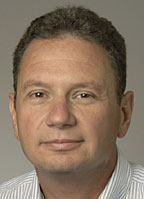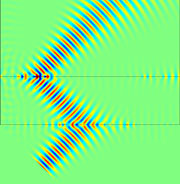| Research
|
On 10 acres outside of Albany, Oregon , about 1,000 Douglas fir trees stand as a testament to nature's own method of sequestration by “drinking up” carbon dioxide from the atmosphere. Those 10 acres belong to Bill O'Connor, a 19-year veteran geologist at DOE's National Energy Technology Laboratory Albany field office. “Oregon is a pretty spectacular place to live,” Bill says, and he knows that his tree farm, and other vegetation, adds to that geographic beauty while serving as a natural collector of CO2. However, Bill's personal hand in addressing the sequestration issue is not limited to his tree farm. He has worked on a variety of sequestration projects in his career. Before joining DOE and NETL, Bill's work in waste detoxification at the Albany Bureau of Mines facility seemed to be a good fit for NETL's sequestration effort. His early research at NETL involved the reaction of gaseous CO2 and reactive minerals to convert the CO2 into a solid as a safe method of storage without leakage. This methodology could provide niche applications for various industrial solid wastes. Bill and the group at Albany subsequently shifted their effort to geologic sequestration of CO2 into saline aquifers, with one focus being the improvement of cement seals at drill holes in critical, high-pressure environments. A peer review of their work with reactive minerals suggested that the research should investigate mineral additions to improve the cements. In partnership with industry and other organizations, Bill has applied his experience to smelting processes that recover metals from spent catalysts. By using a new silicon-smelting furnace at Albany, he has worked to reduce the cost of silicon production. His efforts have been joined by companies such as Engelhard Inc. and Dow Corning, as well as national labs Hanford and Idaho.Submitted by DOE's National Energy |
|||||||||||||||||||||
|
Check out the Office of Science's new Website.
|
Marvelous metamaterials
Costas Soukoulis, a senior physicist at DOE's Ames Laboratory, and his collaborators at the University of Karlsruhe, Germany, are the first research group to fabricate a metamaterial that has a negative index of refraction at 1.5 micrometers—the smallest wavelength obtained to date. Metamaterials are exotic, artificially created materials that can be manipulated to respond to electromagnetic waves in ways that natural materials cannot. They can refract light, or electromagnetic radiation, at a negative angle, allowing enhanced resolution in optical lenses, which could potentially lead to the development of a flat superlens with the power to see inside a human cell and diagnose disease in a baby still in the womb. The development of a metamaterial with a negative index of refraction at 1.5 micrometers by Soukoulis and his Karlsruhe collaborators moves metamaterials into the near infrared region of the electromagnetic spectrum—very close to visible light, superior resolution and a wealth of potential applications. Computer simulations developed by Soukoulis and his research team show how an electromagnetic wave evolves in time as it hits the surface of a metamaterial. The simulations reveal that the incoming beam is refracted in the negative direction as expected, but refraction does not take place immediately. Instead, the incoming electromagnetic wave is temporarily delayed and trapped at the boundary between the air and the metamaterial before it eventually moves in a negative direction. Soukoulis says it is this trapping mechanism that causes the outer rays of the delayed beam to seem as though they are traveling faster than the speed of light. However, his calculations confirm that the speed of light is not violated by negative refraction. Movies developed by Thomas Koschny, an Ames Laboratory postdoctoral fellow working with Soukoulis, help clarify the interactions of electromagnetic radiation within metamaterials and can be viewed on the Web.Submitted by DOE's Ames Laboratory |


